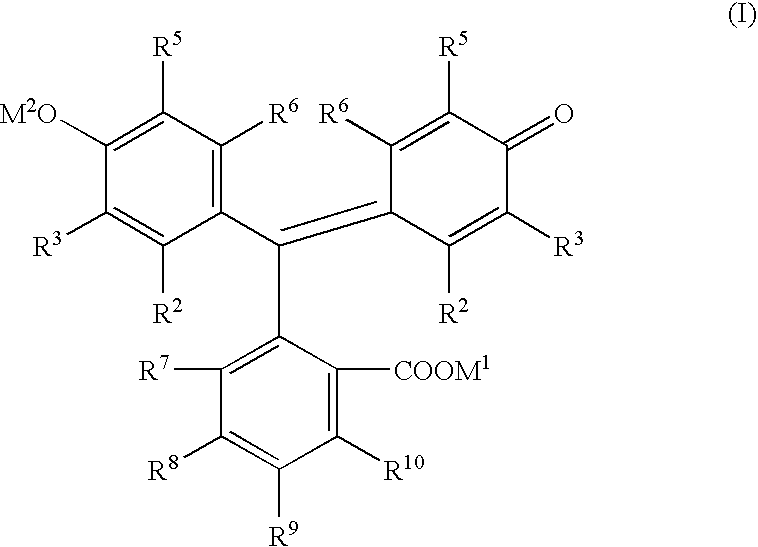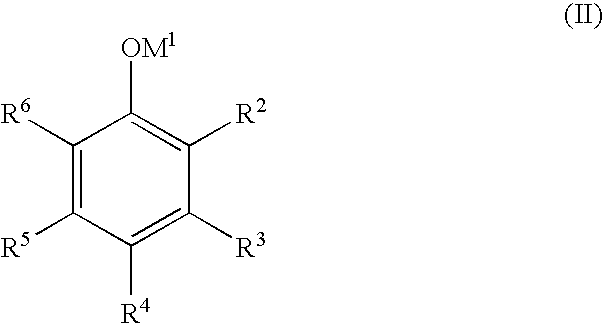Use of color changing indicators in consumer products
a technology of color changing indicators and consumer products, which is applied in the direction of detergent dyes, detergent compounding agents, polishing compositions, etc., can solve the problems of difficult to determine whether the treatment was effective, difficult to visualize when and/or where a surface has been treated, and difficult to establish whether the treatment has been achieved
- Summary
- Abstract
- Description
- Claims
- Application Information
AI Technical Summary
Benefits of technology
Problems solved by technology
Method used
Image
Examples
example 7
Synthesis of disodium salt of 3,3-bis-(4-hydroxy-3-ethoxyphenyl)-1-(3H)-isobenzofuranone
[0192] A mixture of 3,3-bis-(4-hydroxy-3-ethoxyphenyl)-1-(3H)-isobenzofuranone (0.01M) in ethanol (50 mL, 85%) was stirred followed by addition of sodium hydroxide (0.02M) in ethanol (50 mL, 85%). The reaction mixture was stirred and refluxed for 2 hours, cooled to room temperature. The solvent was evaporated on rotary evaporator, isolated the crude product and dried. Recrystallization from ethanol furnished pure disodium salt in 94% yield.
example 8
Synthesis of disodium salt of 3,3-bis-(4-hydroxy-3-acetamidophenyl)-1-(3H)-isobenzofuranone
[0193] A mixture of 3,3-bis-(4-hydroxy-3-acetamidophenyl)-1-(3H)-isobenzofuranone (0.01M) in ethanol (50 mL, 85%) was stirred followed by addition of sodium hydroxide (0.02M) in ethanol (50 mL, 85%). The reaction mixture was stirred and refluxed for 2 hours, cooled to room temperature. The solvent was evaporated on rotary evaporator, isolated the crude product and dried. Recrystallization from ethanol furnished pure disodium salt in 92% yield.
example 9
Synthesis of disodium salt of 3,3-bis-(4-hydroxy-6-methyl-3-nitrophenyl)-1-(3H)-isobenzofuranone
[0194] A mixture of 3,3-bis-(4-hydroxy-6-methyl-3-nitrophenyl)-1-(3H)-isobenzofuranone (0.01M) in ethanol (50 mL, 85%) was stirred followed by addition of sodium hydroxide (0.02M) in ethanol (50 mL, 85%). The reaction mixture was stirred and refluxed for 2 hours, cooled to room temperature. The solvent was evaporated on rotary evaporator, isolated the crude product and dried. Recrystallization from ethanol furnished pure disodium salt in 97% yield.
PUM
| Property | Measurement | Unit |
|---|---|---|
| temperatures | aaaaa | aaaaa |
| vapor pressure | aaaaa | aaaaa |
| temperature | aaaaa | aaaaa |
Abstract
Description
Claims
Application Information
 Login to View More
Login to View More - R&D
- Intellectual Property
- Life Sciences
- Materials
- Tech Scout
- Unparalleled Data Quality
- Higher Quality Content
- 60% Fewer Hallucinations
Browse by: Latest US Patents, China's latest patents, Technical Efficacy Thesaurus, Application Domain, Technology Topic, Popular Technical Reports.
© 2025 PatSnap. All rights reserved.Legal|Privacy policy|Modern Slavery Act Transparency Statement|Sitemap|About US| Contact US: help@patsnap.com



